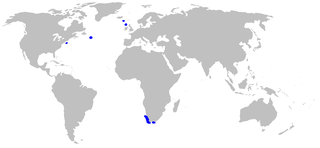
Pyrene is a polycyclic aromatic hydrocarbon (PAH) consisting of four fused benzene rings, resulting in a flat aromatic system. The chemical formula is C
16H
10. This colorless solid is the smallest peri-fused PAH. Pyrene forms during incomplete combustion of organic compounds.

Melamphaes microps is a fish of the genus Melamphaes, found in the North Atlantic, South Atlantic, southern Indian Ocean, and the south west Pacific including New Zealand, at depths of from 1,000 to 3,000 m. Their length is up to 10 cm.

The smalleye catshark is a catshark of the family Scyliorhinidae, found in the southeast Atlantic at depths between 700 and 2,000 m. It can grow up to 61 cm. The reproduction of this catshark is oviparous.
A blind fish is a fish without functional eyes. Most blind fish species are found in dark habitats such as the deep ocean, deep river channels and underground.
Pterosturisoma microps is the only species of the monotypic genus Pterosturisoma, a genus of the family Loricariidae of catfish.

The Ural field mouse is a species of rodent in the family Muridae. It is also known as the pygmy field mouse. It is found in Armenia, Austria, Azerbaijan, Belarus, Bulgaria, China, Croatia, Czech Republic, Estonia, Georgia, Hungary, Kazakhstan, Latvia, Liechtenstein, Lithuania, Mongolia, Montenegro, Poland, Romania, Russian Federation, Serbia, Slovakia, Turkey and Ukraine.

Myersiella microps is a species of frog in the family Microhylidae. It is monotypic within the genus Myersiella. It is endemic to Brazil. Its natural habitats are subtropical or tropical moist lowland forests and subtropical or tropical moist montane forests. It is threatened by habitat loss.

Phrynomantis microps, the Accra snake-necked frog, red rubber frog or West African rubber frog, is a species of frog in the family Microhylidae. It is found in Benin, Burkina Faso, Cameroon, Central African Republic, Democratic Republic of the Congo, Ivory Coast, Ghana, Mali, Nigeria, Senegal, Sierra Leone, Togo, possibly Chad, possibly Gambia, possibly Guinea, possibly Guinea-Bissau, possibly Mauritania, possibly Niger, and possibly Sudan and west Ethiopia - Gambella. P. microps is a medium-sized frog with an elongated and depressed body.

The chisel-toothed kangaroo rat is a species of rodent in the family Heteromyidae.

The common goby is a species of ray-finned fish native to fresh and brackish waters along the Atlantic and Baltic Sea coasts of Europe and northern Africa, with a range stretching from Norway to Morocco and Mauritania. It is also found in the Canary Islands. This species reaches a maximum length of 9 centimetres (3.5 in) TL.
Chiloglanis microps is a species of upside-down catfish endemic to the Democratic Republic of the Congo where it occurs in the Lufira River system. This species grows to a length of 5.6 centimetres (2.2 in) SL.

The Modoc sucker is a rare species of freshwater fish native to northern California and southern Oregon. It grows to a length of about 7 in (18 cm) and becomes sexually mature at 4 in (10 cm). It feeds on algae, small invertebrates and detritus, and hides under stones, detritus and overhanging vegetation. It is found in only a few streams and is listed as an endangered species in California and the United States. Conservation measures have been put in place such as fencing the streams in which it lives from livestock. It was previously rated as "endangered" by the International Union for Conservation of Nature, but this rating has now been changed to "near threatened".
Protonarthron is a genus of longhorn beetles of the subfamily Lamiinae, containing the following species:

Chaetostoma microps is a species of suckermouth armored catfish native to Ecuador. The fish has been filmed climbing cave walls.
Protonarthron gracile is a species of beetle in the family Cerambycidae. It was described by Stephan von Breuning in 1936.
Protonarthron indistinctum is a species of beetle in the family Cerambycidae. It was described by Stephan von Breuning in 1938. It is known from the Democratic Republic of the Congo.
Protonarthron diabolicum is a species of beetle in the family Cerambycidae. It was described by James Thomson in 1858.
Protonarthron dubium is a species of beetle in the family Cerambycidae. It was described by Hintz in 1911.
Protonarthron olympianum is a species of beetle in the family Cerambycidae. It was described by Per Olof Christopher Aurivillius in 1913.
Protonarthron subfasciatum is a species of beetle in the family Cerambycidae. It was described by Jordan in 1894.









